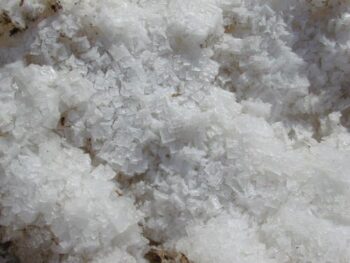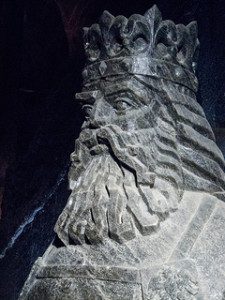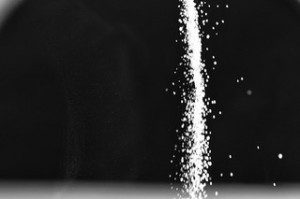
1. To love like salt
“I love you as fresh meat loves salt,” says the daughter in the English folktale “Cap o’ Rushes,” and her father banishes her from his house, domesticity cracked like an eggshell. She goes to the river to weep amidst weeds and thickets, and weaves the rushes she finds there into a long hooded cloak. So disguised, she scrubs dishes in a palace and, as fairy tale scullery maids often do, wins the prince’s heart with her humility and the grace of her pale hands moving through clouds of suds. She agrees to marry him but insists their wedding feast be cooked without salt. Her father, invited as a guest and unaware of the bride’s identity, tastes the bland meat and learns food without salt has no savor. Horrified by how much he misjudged his lost child, he weeps, and, at the sight of his tears, she unveils herself. All is forgiven; father and daughter fall into each other’s arms.
The father’s tears salt his food; the daughter’s tears are dispersed into the marsh beside the river, the wild cranberries like a red constellation around her.
The collision of salt with love is explored more fully in Lisel Mueller’s poem “Love Like Salt,” where salt, like love, is at times inexplicable (“It lies in our hands in crystals / too intricate to decipher”), taken for granted (tossed “into the skillet / without a second thought”), lost (“it spills on the floor”), and yet still an intrinsic part of both ourselves (“we store it inside our bodies / in secret wineskins”) and our communal lives.
Without salt, life has no savor, because without salt we are not human. It is the physical manifestation of the basic triad of our lives: love, work, and grief. We seep salt through our skin as we sweat during sex or hard labor, and we weep when loss guts us. Of course we love each other like meat loves salt: the rough flakes on our tongues are reminders of how we move through the world.
Sodium regulates our electrolytes; each body requires at least a trace level to survive. People can die of water intoxication, a disturbance in brain function caused by drinking too much water without ingesting enough salt. At the opposite end of the spectrum, if you have ever been tempted to engage in a salt-eating contest of some sort, please refrain: an excess of salt can also kill you (the ratio, in case you were wondering, is 1 gram per kilogram of body weight). In this way too, salt is a stand-in for love: too much or too little of it can destroy us.
In platonic terms, accepting salt from a person seals a bond of loyalty. A guest who has eaten “of the salt of the palace” (Ezra 4:14) is obliged to be loyal to the king; so, too, must the king now protect him. In Russia and much of Eastern Europe, the tradition of offering honored guests bread and salt continues—so much so that the Soviet space program offered salt tablets on the Apollo-Soyuz project and pieces of bread with salt at the Mir space station.
Salt is sacramental, a sign of the love between humans and the divine. The Greeks, Romans, and Egyptians all gave their gods gifts of salt, and in Shintoism, small piles of salt are placed in dishes by the entrances of buildings. Called “salt flowers,” these offerings are believed to placate the spirits. The Jainists pair raw rice with salt as an offering of devotion to their deities. For the Jews, salt dipped in bread and passed around the table at seder is a sign of preserving the covenant between God and his people. Catholic priests bless salt to use in rituals such as baptism, reconsecrating a defiled altar, and consecrating holy water. Blessed salt can also be used in exorcisms or sprinkled inside the faithful’s homes for protection. In this way, salt becomes a gift of God’s love for mankind.
The intertwining of love, salt, and the divine sometimes brings us a darker story. Genesis speaks of a woman whose body is transmogrified entirely into salt: Lot’s wife, who becomes a pillar in the desert. We can read religious texts as figurative or literal, whichever best suits us, but cartography names a pillar of salt at the base of Mount Sodom Lot’s wife, and, according to the Mishnah, you must say a blessing when you pass by it. Imagine her soft flesh hardening into halite. Could she feel herself solidifying as the salt rose up her body, not to clog her throat, but to become it? Was she aware of each slow second, or was the shift as sudden as two fingers pressed quick against a candle wick?
The Midrash Aggadah says Lot’s wife was punished because she placed visiting strangers at risk by asking her neighbors if she could borrow extra salt for her guests. Hearing that new people were in their midst, the townspeople stormed Lot’s house, demanding he give them his guests so they could have sex with them. Lot offers his virgin daughters to the crowd instead, but the townspeople refuse him. As the townspeople try to break down the door, Lot’s guests blind the attackers and reveal themselves as angels. Because Lot’s wife used salt to expose them to danger, she was transformed into the substance of her sin. A different exegesis explains she is changed not for betraying her guests, but for a greater transgression: seeing God when he descended to destroy her city. For glimpsing the forbidden divine, she was stilled into salt like a stone.
The most common version of the story, however, says she is punished for disobeying the angels’ command—“Do not look behind you”—as she flees her city. It’s naïve to ask why. Anyone who has ever been broken-hearted understands this. Even though we know it will hurt, we return to messages and pictures of the one who has left us. Ravaged by our loss, we still can’t resist one last look at our irretrievable beloved. So it is with Lot’s wife. She has four daughters, two of whom stay in the doomed city with their husbands. She turns and becomes a kind of anti-Abraham; for loving her children more than God’s command, she is punished.
The tale of Niobe in Greek myth quietly echoes that of Lot’s wife. She, too, suffers because of an excess of maternal love. Proud of her children, Niobe boasts she is greater than Hera because she has borne fourteen children, each as lovely as the gods, to the goddess’s two. The divine twins Artemis and Apollo punish Niobe by killing her children in front of her, shooting them down in a rain of arrows as if they were deer at the hunt. After this slaughter, the gods take harsh pity on Niobe’s grief and turn her into granite, but even then, she continues weeping, salt rivulets carving paths through the rock.
The old stories teach us one of the world’s harshest lessons: If you love too much what you have already lost, your love will destroy you. Longing will leave you isolated and motionless, a salt pillar in the desert or a weeping stone.
2. Origin stories: birth and travail
Under hot sun and soft dry wind off France’s west coast, salt evaporates from man-made clay ponds. Seawater sluices in through a system of pipes like blood thrumming through veins and, as the sun sets, the salt crust reflects like a mirror. If the weather allows, the sauniers harvest coarse gray salt from the ponds’ linings (crystals darkened by clay) or, with a skimmer, cull fleur de sel from the surface where the fine white grains rise and the wind traces patterns across them.
What is it like to read the future in the inscriptions there, your life written out by wind over salt floating on the surface of the water?
Salt is harvested now for the sake of its particular flavor, but the original catalyst was necessity rather than gourmet pleasure. Because of salt’s use in food preservation, transmuting water into salt is one of the oldest alchemies. Ancient saltworks in Romania indicate the Neolithic people boiled salt springs to separate salt from fresh water in 6050 B.C., while in China, salt was being harvested from Lake Xiechi a mere fifty years later.
Not all these salt seas can be seen. Some lie under the ground, hidden like secrets as we walk above them. Miles deep in the earth, enclosed seas and lakes dry into vast beds of halite, rock salt that prisoners and slaves were once condemned to mine. Going there was a death sentence. Breathing in salt dust and absorbing sodium by touching the rough fragments caused rapid dehydration. Most workers lasted only a few months. Under the earth, such a thirst, and yet still the salt waits to be freed.
 In the Wieliczka mine near Krakow, Poland, miners imagined shapes in the salt and hewed figures from it, making their workplace into a museum. The mine was built in the thirteenth century and ceased production in 1996 because of flooding and low salt prices. Now it remains open as a tourist attraction and a health spa. A wooden staircase leads visitors 378 steps down to a chapel and corridors full of carvings. Looking down from his alcove, a king’s stern eyes stare at the flash-camera-toting throngs, his long beard white as receding waves. Jesus in salt blesses the masses as He eats his last supper. St. Barbara, the patron saint of miners and engineers, holds a block of halite in her hand. Sharp rock crystals lace the walls and lie in layers thick as frosting over an abandoned ladder. Tourists wander the mine during the day, while spa guests dance all night at a disco overlooking the salt lake and eat in a grand dining room under clear salt chandeliers that radiate light.
In the Wieliczka mine near Krakow, Poland, miners imagined shapes in the salt and hewed figures from it, making their workplace into a museum. The mine was built in the thirteenth century and ceased production in 1996 because of flooding and low salt prices. Now it remains open as a tourist attraction and a health spa. A wooden staircase leads visitors 378 steps down to a chapel and corridors full of carvings. Looking down from his alcove, a king’s stern eyes stare at the flash-camera-toting throngs, his long beard white as receding waves. Jesus in salt blesses the masses as He eats his last supper. St. Barbara, the patron saint of miners and engineers, holds a block of halite in her hand. Sharp rock crystals lace the walls and lie in layers thick as frosting over an abandoned ladder. Tourists wander the mine during the day, while spa guests dance all night at a disco overlooking the salt lake and eat in a grand dining room under clear salt chandeliers that radiate light.
Salt is born in deep caverns and the ocean, and it returns a generative gift by birthing place-names. Americans may think immediately of Salt Lake and Salt Lake City, while Austrians recognize Salzburg, which rests on the banks of the river Salzach: Salt Water. Hallstatt, a bit further north, takes its name from “hal,” the Celtic root word for salt and so means “salt town”; nearby Hallein translates as “saltwork.” To thread more beads onto this nomenclature necklace, the Dead Sea’s true name in Hebrew is Yam HaMelah, “Sea of Salt”; Tuzla, in Bosnia and Herzegovina, was named for “tuz,” Turkish for salt; and Bulgaria’s Solnitsata (“the saltworks”) may very well be Europe’s oldest town. The word gives us also the Via Salaria, the Roman Empire’s great salt road, which stretched from Porta Salaria (salt gate) to the Adriatic Coast. Some historians attribute the original settling of Rome to the salt trade and, if we continue to talk of salt and origins, the word “salary” derives from the Latin “salarium,” a reference to the commonly held belief that Roman soldiers were sometimes paid in salt.
Cities rose and flourished because of the salt trade as its routes branched like capillaries. Some of the loveliest images of the ancient world come to us via these paths. Imagine, for a moment, the clamor of the port-town marketplace as Egyptians traded salt fish to the Phoenicians. Consider also the Tuareg people, Berbers who traveled across the Sahara between the Tauodenni salt mine in Mali and Timbuktu in salt caravans like slow boats traversing the dry desert sea.
3. Death
Though salt generates and preserves, it is also linked with death. We see this in the harsh salt mines as well as the Dead Sea, which is so named, after all, for the salinity that leaves it almost barren. Adding salt to the earth destroys crops; hence, in small quantities, salt is used as a weed killer by gardeners who don’t want to use chemical defoliants. In the Iliad, Odysseus feigns madness by plowing his own fields with salt in a vain attempt to avoid leaving to fight the Trojan War. (His ruse is discovered only when doubters place his infant son in front of the plow.) Many ancient texts detail how victors salted the earth of cities they destroyed to render them uninhabitable. Legend has it the Romans salted the ruins of Carthage, and Pope Boniface is said to have not only salted but plowed under the remnants of Palestrina after conquering it in 1299. In the Book of Judges, Abimelech sows his own city with salt to punish his people after they revolt against him.
 On a smaller scale, historical record reveals a similar fate for the lands belonging to convicted traitors in Spain and Portugal. First, a swift blade through the neck. Then the traitor’s head was placed on a pike so his dead eyes could watch soldiers demolish his house and seed salt into his land. This was done as late as 1759 to the Duke of Aveiro, whose palace in Lisbon was destroyed after he conspired against King Joseph I, as well as to Tiradentes, the leader of an independence movement that attempted (unsuccessfully) to free Brazil from Portuguese rule in 1789. Planting salt in the earth like this is a reversal of nature: each grain is a tiny death rather than a seed that will flourish into a tender green stem.
On a smaller scale, historical record reveals a similar fate for the lands belonging to convicted traitors in Spain and Portugal. First, a swift blade through the neck. Then the traitor’s head was placed on a pike so his dead eyes could watch soldiers demolish his house and seed salt into his land. This was done as late as 1759 to the Duke of Aveiro, whose palace in Lisbon was destroyed after he conspired against King Joseph I, as well as to Tiradentes, the leader of an independence movement that attempted (unsuccessfully) to free Brazil from Portuguese rule in 1789. Planting salt in the earth like this is a reversal of nature: each grain is a tiny death rather than a seed that will flourish into a tender green stem.
With death comes the tomb, and salt also has its place there. The ancient Egyptians left it as a funeral offering, while in Jainism, salt is sprinkled on cremated remains before the ashes are buried as both gift and sanctification.
Perhaps this is what Neruda means when, in “Ode to Salt,” he tenderly tells the salt it is a kiss from the sea in which “we taste finitude.” Salt reminds us we are finite, that we have limits and boundaries—in our loves who may at any time leave us, in the work we can do before we lay down our tools, in our lives which begin with our mothers weeping in pain and end, if we are lucky, with our friends and family gathered around us to grieve our passing.
Listen to Kate read her essay:
***




